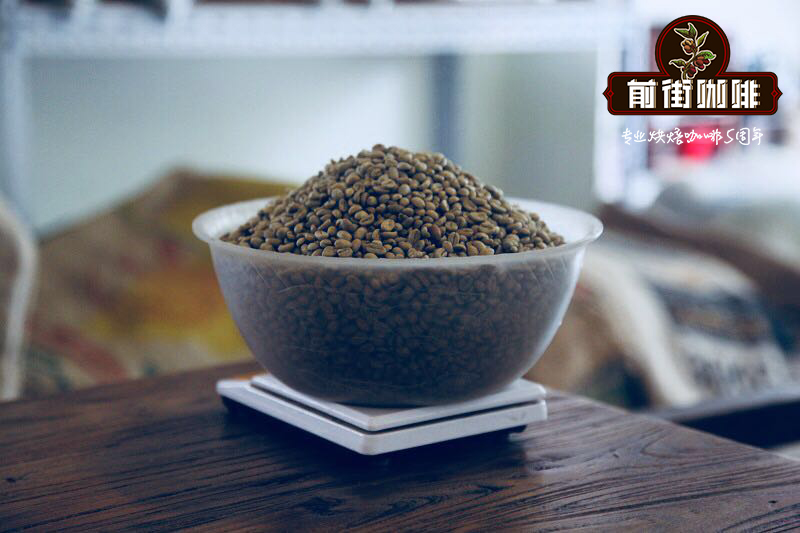The story of Ethiopian coffee beans is the price of Ethiopian Humbera Sakui coffee beans expensive?

Professional coffee knowledge exchange More coffee bean information Please pay attention to coffee workshop (Weixin Official Accounts cafe_style)
Ethiopia Travels 2018 (1) Amber Totem
Coffee is an amazing crop.
Whether it's rice farmers in Thailand or sugar cane workers in Brazil, they work hard at sunrise and sunset, and the seasons change, and sweat into the soil in exchange for rewards. This kind of life is said to them as a habit of generations and a necessity of life. So they probably don't have a spiritual connection or worship to their crops. The impression is that Aomori stores like to turn local specialties (apples) into cartoon characters, and hold festivals during harvest season to promote a series of by-products. I can't tell if it's a commercial stunt or if they're genuinely sharing joy. But compared to Ethiopians, these are superficial. Because coffee is not just a crop, it's part of existence.
I calculated in my heart, how many glasses of red wine will French wineries drink every day? Even if you drink it, it may also be to greet the buyer, or to test the quality of the product. People often ask me if I drink a lot of coffee every day. I tend to be vague, either because I don't say much of the answer, as if it were a bit disrespectful, or because it didn't meet expectations. To be honest, nowadays coffee is often judged critically. Even if you happen to drink coffee while traveling, you can't escape an occupational attack. Use an invisible ruler in your heart to measure and compare. I'm a little embarrassed to think about it.
Ethiopian men, women and children drink coffee every day. Since childhood, he has been exposed to this amber liquid. But the locals are more solid and everyday than the image I was inculcated with of coffee in the developed world. Coffee is the mother's actions and expressions when entertaining guests at home, or the afterheat of charcoal used to boil water when the sun sets. It may be part of the building materials or a hillside surrounding the village for children to walk around. In ancient times, coffee was not only a drink, but also an important accessory for sacrifice, red and white.
Originally, I wanted to compare things in life such as "eating dumplings needs vinegar" or "watching movies needs popcorn", but it seems that there is always a lack of deep connection. If you think about it seriously, the situation is probably like the moon and mooncakes on Mid-Autumn Festival: mooncakes are commodities, but the moon is part of the environment. I think coffee to Ethiopians is like a moon that exists forever, more than a moon cake that is processed. Coffee chose Ethiopia rather than Ethiopians chose coffee.
Although the country was not colonized by European powers, inter-ethnic hatred and conflict occurred from time to time. Last year I cancelled my trip because of the destruction of many parts of the coffee producing area. From an industry perspective, I wanted to see how this country, which is considered the origin of coffee, is adapting to the rapid development of the industry, and understand what coffee means to the local people, especially the original tribal people, and photograph the magnificent scenery of the African Rift Valley. This trip began when a local friend invited me to write a preface to his forthcoming book.
Ethiopia Travels 2018 (2) Chate Grass in Rift Valley
A travel program about Africa was playing in the departure lounge of Qingquan Gang Airport.
I didn't actually look at the TV screen. What my retina recorded was a shimmering box between the flight status screen and the plane parked outside the window, and the light emitted from it contained lines and colors that resonated with a particular scene in my memory file and reminded me of several landscapes.
I continued to bury my head in the yellow copy of the score paper in my hand, recalling the taste of coffee. Within three days, we evaluated more than 80 works in Alishan. The taste that once stayed on the tip of his tongue was like oil paint on canvas, covered by layers and layers. The dense fine print on the back page of carbon paper is no longer clear (what is written at the moment of lightning can not be described as clear). But looking at it as a whole (not reading, because it is unclear) seems to evoke sensory sensations at a moment in memory. Printed in black ink, the regular lines are covered with left and right marks. I struggled to find the coffee that gave me the same shock in the preliminary round and the final round. What was my mood when I recorded the taste on paper? The handwriting on the carbon paper was like a shadow in the hot sun. I do recognize myself from the outline, but just as shadows change with the position of the sun, so the things I write are affected by the mental effects of coffee. For this observation, I believe that only you will notice it.
Jasmine, bergamot, tropical fruit, honey, grapes, smooth taste. I read my own review of the coffee while listening to the TV host's frightened voice as he crossed a dried river.
Is it Guixia? Memories are like chain reactions triggered by the moment a bowling pin is knocked down. My subconscious probably recognized the TV screen showing the African Rift Valley I had recently visited. This scene evokes the impression of African coffee, especially summer. So unconsciously, label the most recent coffee with that flavor. One answer, like dominoes, solved another problem. Whether this is the case or not may require a little more coffee. Memories jump so freely, and the camera of the TV program also circles in the mountains. Finally my eyes focused on a group of girls whose hair was smeared with orange dirt. They are singing and dancing on the grassland, almost pleading to hand over the cane whip to the boys belonging to the Turmi tribe, asking them to whip themselves and leave scars symbolizing happiness on their bodies.
The host introduced local customs with a surprised expression. And I think back to the coffee pot that wasn't ingested. Even if I told them that "coffee with jasmine, bergamot, tropical fruit, honey, grapes is likely to be found near the village, that's Rose Summer" they would probably be as confused as most consumers who are not interested in coffee. If you want to communicate with them, it is better to find a hot topic.
On that trip, I visited villages of different tribes. In addition to girls covered in scars, there are also different customs and cultures such as naked boys jumping on the backs of cows, and the need to lift and throw dozens of pounds of stones before they are eligible to marry. The most shocking thing is the widespread cultivation of Chate grass. A few years ago I heard a local producer say that because of the high quality of coffee in the Rift Valley, there was no incentive to give up growing chateau. However, due to the huge demand from neighboring countries such as Somalia, the continuous decline in coffee futures prices and geopolitics. More and more local people are choosing to grow this plant, which consumes a lot of water and turns the soil acidic.
Ethiopia Travel 2018 (3) Coffee, at least boiled
In front of the jeep, a young shepherd boy was waving a whip and gathering up cattle and sheep scattered on the road. He did not do this to clear the way for us, but because not far away another group, also occupying the entire road, was approaching us. In the Rift Valley tribes, household wealth is calculated according to the livestock they own. It is said that it takes 30 sheep to marry a wife, so the two batches in front of me are equally matched.
The leader was a brown cow. Its short horns were used as reels, and a few loops of nylon rope were tied around them, looking like the white headband that cartoon characters wear when they cheer themselves up. Rather than being the leader, it was simply moving faster, and its companions did not mind following it. All local cattle are thin and the ribs are clearly outlined. Is it because of exercise or because there is no food? But when I think about it, I don't feel right. Should prairie grasses be readily available, or do they eat only certain kinds of grass? It wagged its tail and walked leisurely forward. Until I came back, I did not have the opportunity to discuss this matter with others. Anyway, everyone was more interested in coffee. But when friends look at the photos, they notice a peak on the cow's back. It turned out that this cow was called Borana, a breed unique to the Oromia region and able to survive in harsh environments. That peak, like the camel's, is used to store water.
Two groups of more than 100 cattle and sheep walked head-to-head on the narrow dirt road. The moment they passed each other, they flowed smoothly like tides flowing over stones without splashing. If they see me on the MTR platform every day after work, bumping with passengers getting off like a ball, trying to get into the advantageous position of the train before others, they will probably feel really superior.
The Shepherd Boy nodded slightly to the person opposite him, and the other party's response was also flat. They looked forward to each other and returned to the animals. Perhaps accustomed to it, they will see this moment as part of the landscape. Just like the bus driver driving on the circular route, when he sees his colleague across the road, his expression is indifferent. Under the prairie sky, the same route, the same animal, stirred the same dust for generations.
I was wondering whether the shepherds would notice if one of the sheep had turned around and followed the flock opposite, when I was interrupted by a knock on the car door. A few children ran out of the nearby jungle as the car slowed down. It seemed that they were used to identifying vehicles carrying tourists.
“Highland?Highland?”The leading boy kept shouting through the half-opened window. The ill-fitting jersey was covered with mud. On the wrist that tried to reach into the car, there was a hand rope embroidered with the Ethiopian flag, composed of green, yellow and red. Unshod toes are rough. Hiding behind him was a younger boy, guarding a yellow rubber cube. I thought it was his brother. More and more children rushed to our car. The scene was even more chaotic than the herd of cattle and sheep in front of us. It was similar to the subway platform at work.
The driver opened the window and threw the empty bottle to one of the girls outside the car. "Highland was originally a local brand of bottled water," he explained."They were not asking for money, they just wanted more containers for water. The villagers set out before sunrise to fetch water from a nearby river. In a year or two, these kids will be involved. If you run out of water, give them your empty bottle." The yellow bottle beside the boy is the most commonly used one in the area. If it was filled with water, it would weigh more than five kilograms. It was probably not something that a child of this age could lift. When I was a child, I watched documentaries and always thought Africa = hot = dry, and Ethiopia was like a desert. In fact, there are water sources in many places in the area, but due to poor infrastructure, many people in the villages have to spend a few hours every day to get clean water. Forty-five per cent of the school-age children there choose to hang around on the streets instead of attending primary school, in order to reserve time for their families 'water needs. According to an article published by the United Nations Children's Fund (UNICEF) in March, residents of underdeveloped areas around the world (especially women and children) spend a total of 200 million hours a day travelling (mostly on foot) to get water.
That day, I visited two villages and saw many unique customs. As usual, the villagers greeted the guests with a coffee ceremony. They sat in the open by the house of hay. The mud on the ground was exposed to the sun, and it emitted a residual temperature that was incompatible with the evening sky. The moment the water boiled, light smoke rose from the pitch-black Jabena's mouth. Not far away, there was the noise of the team that had set out to fetch water in the morning returning safely. People in the same group discussed whether local children could not sleep after drinking coffee, or whether the extraction ratio and water temperature of coffee were too high. My eyes were fixed on a child not far from the crowd. He was scooping up half of the gourd shell from a pool of water on the ground. That pool of water had been trampled by cattle and sheep not long ago.
A burning sensation came from his fingertips. As I converted "200 million hours is how many years", I fantasized "how many civilizations can be built in this time". My conclusion is that it is healthy for local children to start drinking coffee from an early age, simply because the water used to make coffee has been boiling.
About the Author: Patrick Tam
Hong Kong's first European and American boutique coffee association barista, cup tester, international judge of Cup of Excellence coffee competition, columnist, university guest lecturer, founder of boutique coffee shop Knockbox
Not immune to caffeine, but not resistant to cafe coffee; a cup of tea for yourself is very simple, but not bitter and not dirty.
He was obsessed with photography. A pile of antique mirrors, also because of coffee and rebirth: take pictures of farm drops, with photos as a bridge, the distance between consumers and farmers shortened.
Coffee is not only a hobby, but also a way.
Ethiopian coffee beans
Front Street Coffee roasts Ethiopian coffee beans with full guarantees of brand and quality. More importantly, the cost performance is extremely high, a pack of half pounds 227 grams, the price is only about 90 yuan. According to the calculation of 15 grams of powder per cup of coffee, a pack can make 15 cups of coffee, each cup only costs about 6 yuan, compared with the coffee shop sells hundreds of dollars a cup price can be regarded as conscience recommendation.
Important Notice :
前街咖啡 FrontStreet Coffee has moved to new addredd:
FrontStreet Coffee Address: 315,Donghua East Road,GuangZhou
Tel:020 38364473
- Prev

Ethiopian Coffee Bean Cochel producing area Story how much is a cup of Ethiopian coffee washed?
Professional coffee knowledge exchange more coffee bean information please follow the coffee workshop (Wechat official account cafe_style) ETHIOPIA,YIRGACHEFFE,KOCHERE in 1995, Ethiopia redivided the area, we are familiar with Yirgacheffe in the new SNNPR planned in the Gedeo district. Currently, Yega Xuefei is located in the middle of Gedeo, Ko.
- Next

Changes in Ethiopian coffee producing areas how much Ethiopian coffee beans cost half a pound
Professional coffee knowledge exchange more information about coffee beans Please follow the coffee workshop (Wechat official account cafe_style) now a lot of the coffee we drink is made from Arabica coffee beans. Ethiopia is not only an important producing area of Arabica coffee beans, but also the largest producer of Arabica coffee beans in Africa. 15 million people live on it, so it is an important economic branch.
Related
- Does Rose Summer choose Blue, Green or Red? Detailed explanation of Rose Summer Coffee plots and Classification in Panamanian Jade Manor
- What is the difference between the origin, producing area, processing plant, cooperative and manor of coffee beans?
- How fine does the espresso powder fit? how to grind the espresso?
- Sca coffee roasting degree color card coffee roasting degree 8 roasting color values what do you mean?
- The practice of lattes: how to make lattes at home
- Introduction to Indonesian Fine Coffee beans-- Java Coffee producing area of Indonesian Arabica Coffee
- How much will the flavor of light and medium roasted rose summer be expressed? What baking level is rose summer suitable for?
- Introduction to the characteristics of washing, sun-drying or wet-planing coffee commonly used in Mantenin, Indonesia
- Price characteristics of Arabica Coffee Bean Starbucks introduction to Manning Coffee Bean Taste producing area Variety Manor
- What is the authentic Yega flavor? What are the flavor characteristics of the really excellent Yejasuffi coffee beans?

